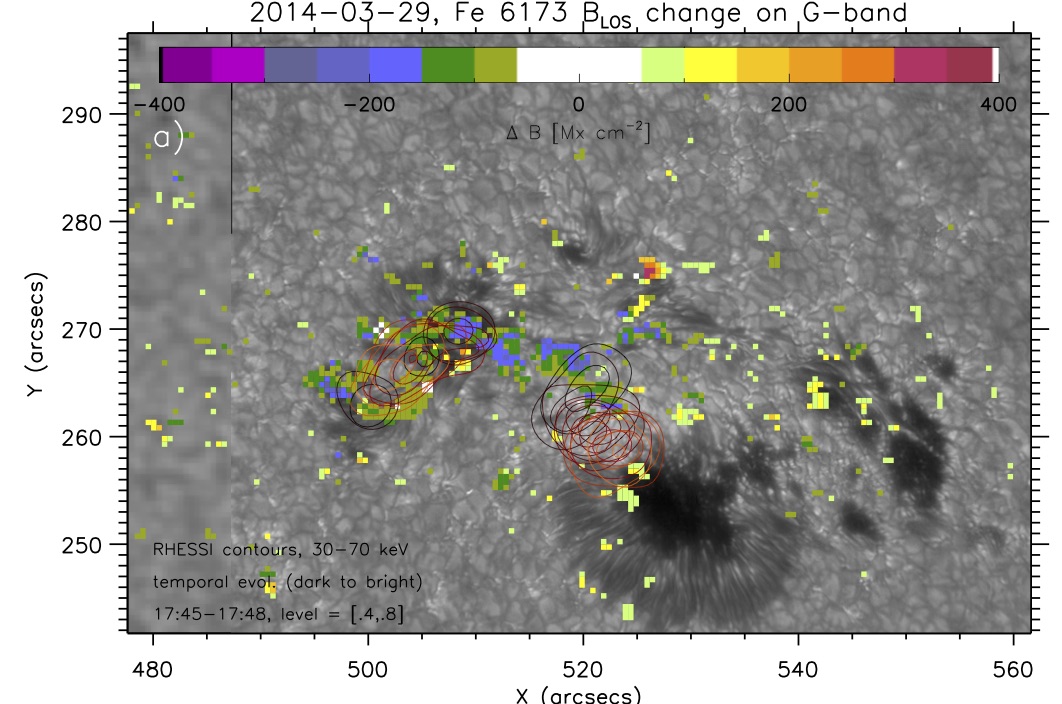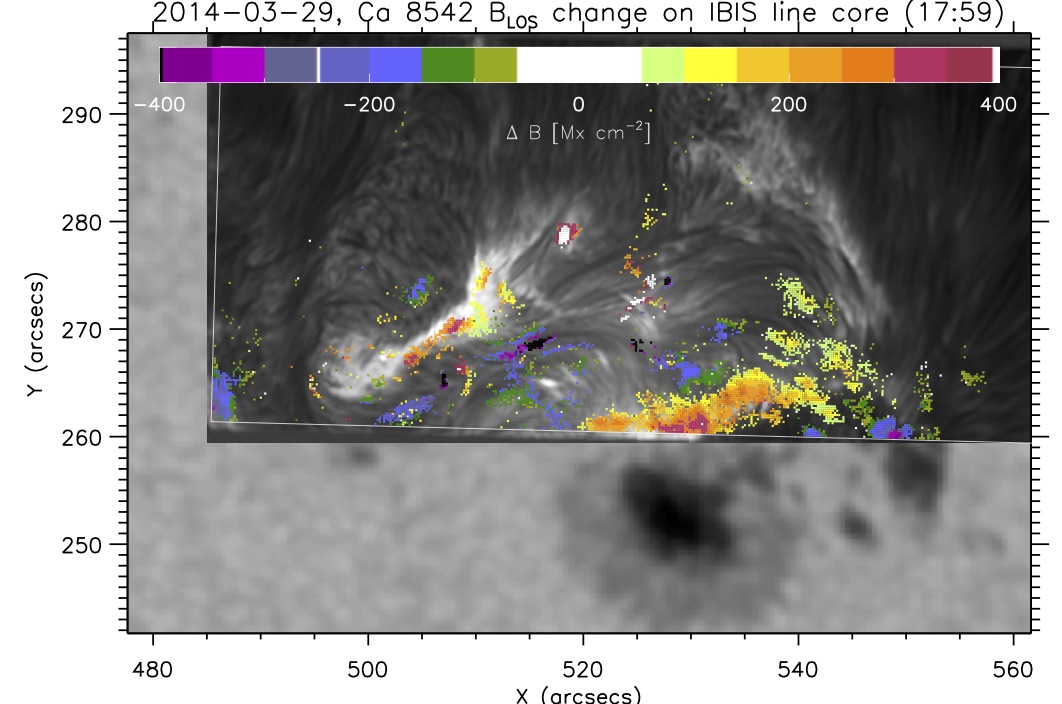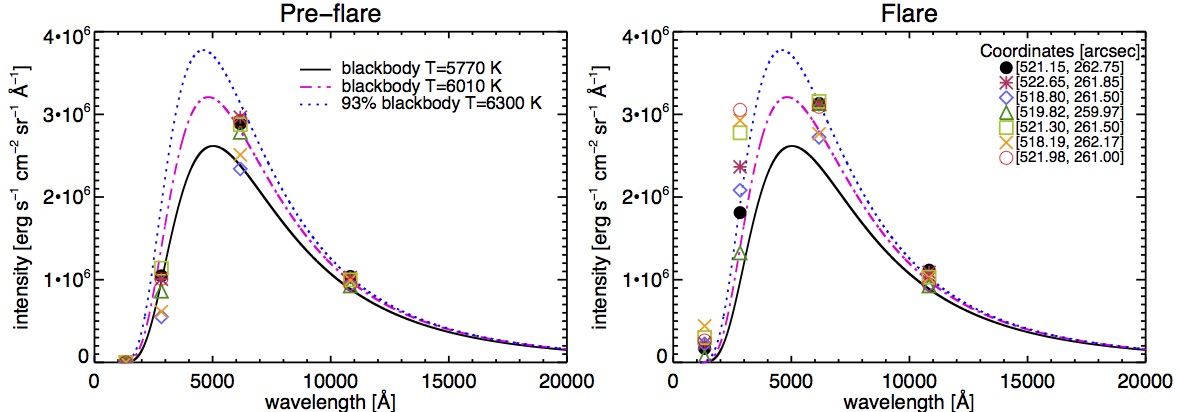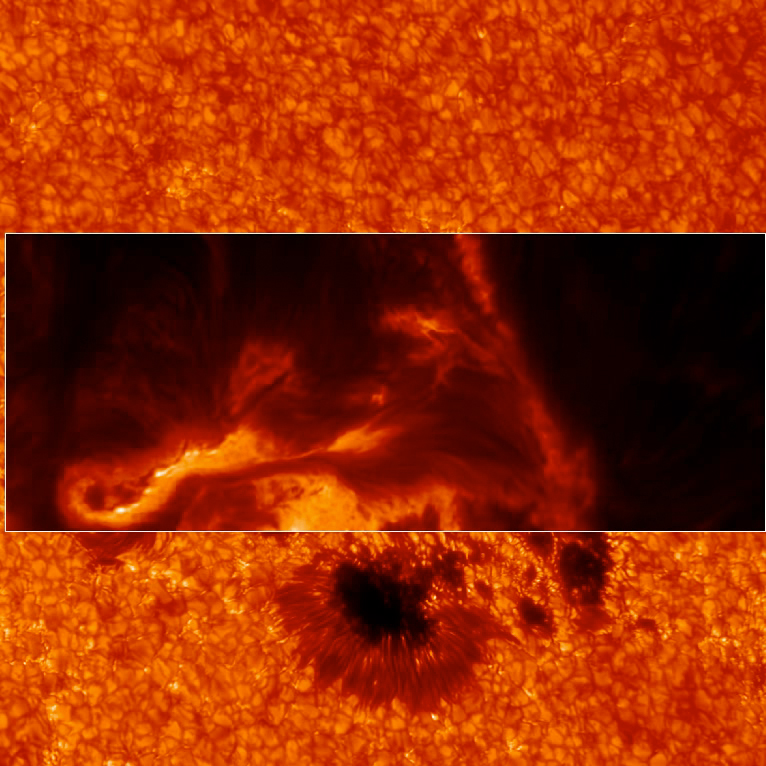
Lucia Kleint
Research
Changes of the Magnetic Field during
Flares
The photospheric magnetic field has been
found to change during flares in many observations. It
is however unclear which mechanism transports the required
energy through the solar atmosphere. In contrast,
chromospheric magnetic fields are very difficult
to measure, both because of the lower signal and
because of the more complex interpretation due to
non-local thermal equilibrium.
We obtained the
first high-resolution chromospheric polarimetric
flare data and found stepwise chromospheric magnetic field
changes during a flare (Kleint,
2017). The chromospheric changes are stronger and
occur in a larger area. They are located near
footpoints of loops, in contrast to photospheric
changes which predominantly occur near neutral
lines. A surprising result was a difference in
timing, sign, and size of the changes when
comparing the two atmospheric layers. Another
surprise was that a model of contracting loops is
not compatible with the observed direction of
changes. Instead, we rather interpret the changes
as an untwisting of loops, but future vector
magnetic field measurements will need to verify
this hypothesis.


Left: Photosphere (background)
with color-coded photospheric magnetic field
changes and contours of hard X-ray
radiation. Right: Chromospheric magnetic field
changes. From (Kleint,
2017).
| Changes of the Magnetic Field during Flares | |
| The photospheric magnetic field has been
found to change during flares in many observations. It
is however unclear which mechanism transports the required
energy through the solar atmosphere. In contrast,
chromospheric magnetic fields are very difficult
to measure, both because of the lower signal and
because of the more complex interpretation due to
non-local thermal equilibrium. We obtained the first high-resolution chromospheric polarimetric flare data and found stepwise chromospheric magnetic field changes during a flare (Kleint, 2017). The chromospheric changes are stronger and occur in a larger area. They are located near footpoints of loops, in contrast to photospheric changes which predominantly occur near neutral lines. A surprising result was a difference in timing, sign, and size of the changes when comparing the two atmospheric layers. Another surprise was that a model of contracting loops is not compatible with the observed direction of changes. Instead, we rather interpret the changes as an untwisting of loops, but future vector magnetic field measurements will need to verify this hypothesis. | |

 Left: Photosphere (background) with color-coded photospheric magnetic field changes and contours of hard X-ray radiation. Right: Chromospheric magnetic field changes. From (Kleint, 2017). |
| Dissipation of Flare Energy: Continuum Emission | |
 Intensities of several pixels before
(left) and during the flare (right). The
enhancement is largest in the NUV because of the
contribution of the Balmer continuum. A simple
blackbody-fit, as is often used, is not a good fit
for flare enhancements. From (Kleint
et al., 2016)
Intensities of several pixels before
(left) and during the flare (right). The
enhancement is largest in the NUV because of the
contribution of the Balmer continuum. A simple
blackbody-fit, as is often used, is not a good fit
for flare enhancements. From (Kleint
et al., 2016)
|
Continuum emission, sometimes also called
white-light emission, is a long-standing puzzle of
flare physics. It is unclear how the photosphere
can be heated by a few hundred degrees because
electron beams are thought to be stopped higher up
in the chromosphere. Additionally, continuum
emission is not purely photospheric, but also
contains contributions from optically thin
recombination radiation (Balmer, Paschen,
... continua) forming in the chromosphere.
In a study of the best-observed flare, the first X-flare that was observed by IRIS, we found strong enhancements in the NUV, which we interpreted as the Balmer continuum (Heinzel & Kleint, 2014). By combining spectral points from the UV to the IR we were able to determine that this flare had continuum emission contributions from the photosphere and the chromosphere, which support a scenario of ''backwarming'' where energy is radiatively transported into the lower solar atmosphere (Kleint et al., 2016). The energy contained in the continuum emission is ~10%-20% of the energy of accelerated electrons >20 keV, indicating that other energy dissipation mechanisms need to be explored as well.
In a study of the best-observed flare, the first X-flare that was observed by IRIS, we found strong enhancements in the NUV, which we interpreted as the Balmer continuum (Heinzel & Kleint, 2014). By combining spectral points from the UV to the IR we were able to determine that this flare had continuum emission contributions from the photosphere and the chromosphere, which support a scenario of ''backwarming'' where energy is radiatively transported into the lower solar atmosphere (Kleint et al., 2016). The energy contained in the continuum emission is ~10%-20% of the energy of accelerated electrons >20 keV, indicating that other energy dissipation mechanisms need to be explored as well.
| The best-ever observed flare |
 Photosphere (background) and chromosphere (inset) during the X1 flare on 2014-03-29 taken at the DST.
Photosphere (background) and chromosphere (inset) during the X1 flare on 2014-03-29 taken at the DST.
|
X-flares are the strongest and rarest types of
flares. There so far is no way to predict when or where a
flare will occur. It is therefore very rare to observe them with
high-resolution telescopes, which only see a small percentage of the
solar surface. But on March 29, 2014 we achieved something unprecedented:
We coordinated a flare-observing campaign at the ground-based Dunn Solar
Telescope and caught an X1 flare together with coordinated spacecraft
observations whose pointing we had to guess and request a day in advance.
The observations are so special that they resulted in a live NASA
press conference and several press releases, e.g.:
These observations led to several publications and
new insights into flare physics. A selection of
different publications:
- Overview of the data: Kleint, Battaglia, Reardon et al., ApJ 806, 9, 2015
- Searching for the origin of a sunquake: Judge, Kleint, Donea, et al., ApJ 796, 85, 2014
- Analyzing electron beams: Battaglia, Kleint, Krucker, Graham, ApJ 813, 113, 2015
- Explaining He 10830 linear polarization: Judge, Kleint, Sainz Dalda, ApJ 814, 100, 2015
- Data-driven radiative hydrodynamic modeling: Rubio da Costa, Kleint, Petrosian, et al., ApJ 827, 38, 2016